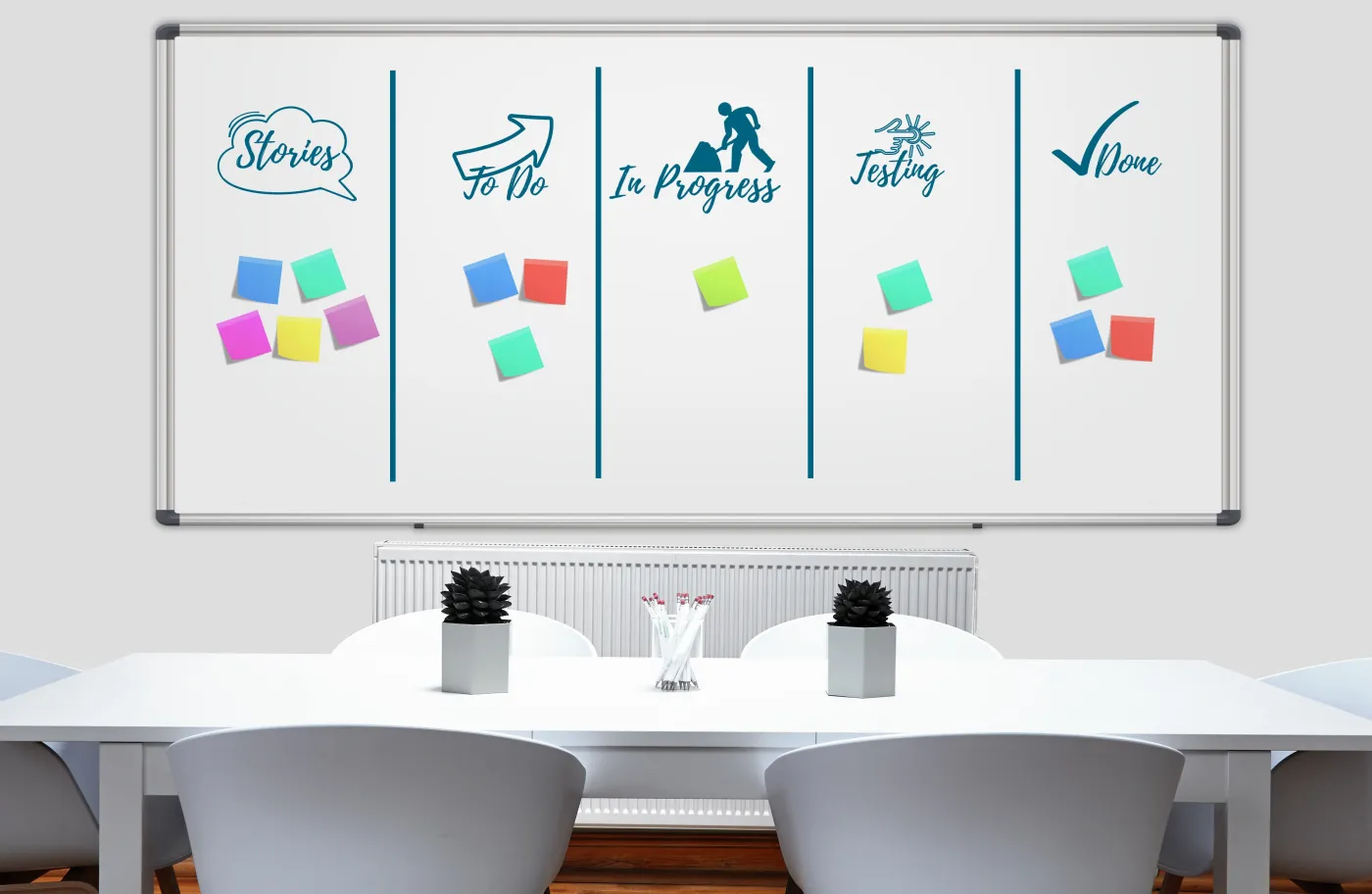By anyone’s measure, 2020 was quite the year for digital learning!
In early 2020, as lockdowns started, more and more of us went live online. The eLearning Guild survey in March 2020 found that 86% of respondents had at least one or more events moving to an online format.
We’ve all seen the stats about how many millions of people are using Zoom, Teams, Adobe Connect and so on. MarketWatch have predicted that virtual classroom market will have a nearly 10% annual compound growth rate over the next five years. This prediction is from November 2020, not a pre-Covid stat, so makes it all the more pressing we focus on skills development for live online skills.
There are some key changes that are shaping the world of live online learning, and here are five I’m seeing specific to live online learning since 2020:
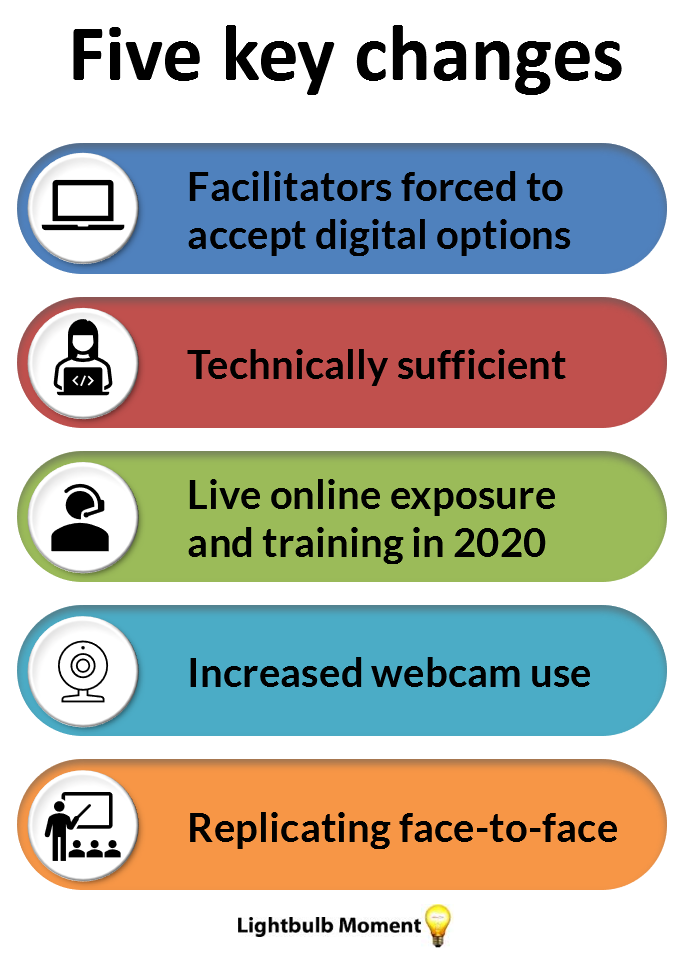
1) During 2020 most of us didn’t have much of a choice about whether to use digital options at all. We’ve hosted on webinars where people were saying that live online sessions saved their business, so we know it’s been important.
2) A lot of people, facilitators and attendees alike, got much more experienced in technology! So many more people got comfortable attending live online learning or dealing with digital communications.
3) We’ve all had a LOT more exposure to live online learning in 2020, and that meant our skills in how to deal with people who were remote and still offer good learning rapidly increased.
4) Also everyone’s use of webcams increased, most people were a lot more comfortable being on webcam for meetings and training by the end of the year… even if they were a bit Zoomed out by then!
5) And we got much better at working out how to do our face-to-face learning experiences in a virtual way.
All of this is great, as things in the virtual world have really advanced very quickly. But there’s always a flipside, and it’s this that I want to explore more.
1) Facilitators were forced to accept digital interventions…
…But is that going to stick?
When the pandemic hit and it was either go digital or go on furlough, there was often little choice about whether to embrace ways of working that were different to the physical classroom.
This is from the CIPD report “Digital learning in a post-covid-19 economy” of January 2021.
“A lack of acceptance of digital learning technologies and ownership among instructors for the successful implementation of digital learning technologies were key instructional barriers.”
We were forced to use live online over the last year and a half, but will it stick? Now that lockdown restrictions are lifting, are we going to rush back into the classroom? How many people can safely be in a physical classroom together and still be cost-effective? This blog by Andrew Jacobs explores that last point.
There’s a lot to consider, let alone our own attitudes to this way of working.
2) Technically sufficient…
…But not savvy.
We are seeing more and more people comfortable with the basic technology of their platforms like Zoom and Teams. But is it enough? Do we need to be more fluent with the technology we are using?
We weathered the Covid-19 storm by getting live online really quickly. At Lightbulb Moment we had some clients who’s training just had to continue for a variety of reasons, and had days or hours to get to grips with doing so virtually. In tight timelines and under stressful circumstances there were varying degrees of success and people forgave us for any stumbles, everyone understood.
However a lot of people have only focused on the basics and haven’t spent time looking at how to use the platforms and external tools to make their learning offerings better.
And we are at the point now of needing to be more adaptable and flexible.
In a tweet from Donald H Taylor, the need to continue forwards is highlighted:
L&D ADAPTED to the pandemic shock. In the future, we will ADVANCE with better systems. In the middle we need to consciously ADOPT new ways of working, reject bad practice, and choose new tech. Without this phase, we'll be stuck with reactive, non-strategic, emergency approaches. pic.twitter.com/OK6UDmcEk2
— Donald H Taylor (@DonaldHTaylor) May 13, 2021
3) Exposure and upskilling during 2020…
…But what about levelling up in 2021?
We know that doing something really helps us to retain knowledge and develop expertise, and we certainly will have had a lot of that with live online delivery recently.
If we aren’t skilled at something though, we aren’t going to do it well or even want to do it! That’s fine if you don’t enjoy running and do dancing instead, but when we look at workplace learning, we can’t have that attitude if we want to be impactful in our work and still be in this industry.
Also from the CIPD report “Digital learning in a post-covid-19 economy” this quote highlights how much our own choice, or the investment of the organisations we work in, of skills development and attitude makes such a huge difference to the quality of what we offer.
“Clearly, very different skills and instructional and learning engagement techniques are required for digital learning compared with traditional in-person and classroom delivery.
Before the pandemic, research studies have shown that the pace of online learning development and expansion of digital offers had definitely been inhibited due to this lack of facilitator skills in using digital learning methods and wider resistance to learning and using them.”
An essential element to move forwards is ensuring that you or your staff know how to design and facilitate for live online learning and in the platform you use.
The bigger picture of investing in and focusing on learning culture and communication with the stakeholders in the business about changing needs is all part of this too.
4) More comfortable with webcams…
…But does it cause challenges?
Going back to 2018 and 2019 in our virtual classroom training courses, it was very rare that our attendees would be comfortable on webcam. The majority of the sessions we ran I might use the webcam at the introduction and that’s it, all the while delivering content and having discussions without seeing the people I was training – that was normal for me.
But 2020 changed all that, and I’m sure you’ve experienced it too!
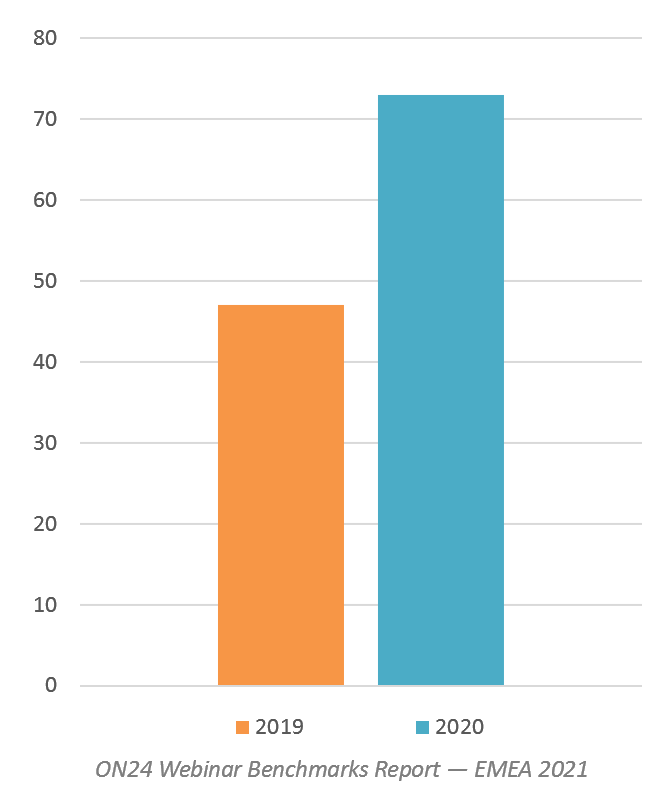 In a report from webinar company ON24 in May 2021, they share that video (webcam and video files) use in webinars has gone up 26% from 2019 to 2020. This is a massive change in a very short amount of time, and for a lot of trainers and attendee’s alike it’s a great thing.
In a report from webinar company ON24 in May 2021, they share that video (webcam and video files) use in webinars has gone up 26% from 2019 to 2020. This is a massive change in a very short amount of time, and for a lot of trainers and attendee’s alike it’s a great thing.
It’s great to see people, to read their facial expressions and see where they are. Zoom research shows that people trust more and are more engaged when webcams are on. It’s not surprising, as we get so much rich information from seeing people and feeling more like we are with them.
As always though, there’s always a downside to things. We are seeing lots of trainers and organisations rely on webcams to overcome that distance and what they perceive as the barrier of the technology. Research from PowerPoint design agency Buffalo 7 showed that 73% of people had video call anxiety and in the links we’ll share at the end there’s research to show that video and webcams aren’t always that engaging.
If there are bandwidth or personal issues that mean webcam use isn’t preferred, we need to respect that. Far more important is to focus on using interactions, discussions and activities to develop that feedback loop with your learners in a whole new way.
Interactivity to “see” people
This is about doing more interactions and activities with the platform you have, like Webex, Zoom and so on, or external tools like Mentimeter, Padlet and others. You can use all sorts of feedback icons and emoticons to start conversations, to get quick feedback from people where you would normally expect nods in a physical setting.
Chat is an amazing tool to use. What is it that people are typing in, who types long or short messages, what does that mean about your attendees? Who volunteers to speak or do activities… all sorts of things that you can do virtually are versions of what you see when you are physically together and it makes it so that you are really aware of the people with you, even if you can’t see them.
This is called Digital Body Language and it’s something we need to know more about in order to facilitating live online learning well. Read an intro blog about Digital Body Language and this website more information, videos and webinars.
5) Replicating face-to-face…
…But slavishly so.
It’s great to have use your skills and experience from physical training. But live online is a different modality than face-to-face. When we try to exactly replicate a physical classroom, we miss out on the thinking that encourages creativity and adapting our sessions to make the most of this way of being together.
The below graph is from Digital Promise in the USA, looking at student’s experiences of their university courses before and after the change to live online learning. At the top of the graph there were things that were better or the same experience when delivering virtually, which is great.

Read more and get a link to the original report here
But towards the bottom there are more things that students experienced as being worse online, things like:
- Feeling included
- Keeping interested in the content
- And opportunities to collaborate
This highlights areas in design and facilitation to focus development on.
When live online events are poorly designed and delivered they have a detrimental affect not only on people’s learning, but also on their performance, motivation and, in some cases, even their mental health. We recorded a podcast unpicking some of the detail of a live online event that had just this awful impact and I think it makes important listening to any learning designer, as well as specifically for virtual.
You and planning your virtual classroom
The Redback report diagram highlights that we need enthusiastic presenters.
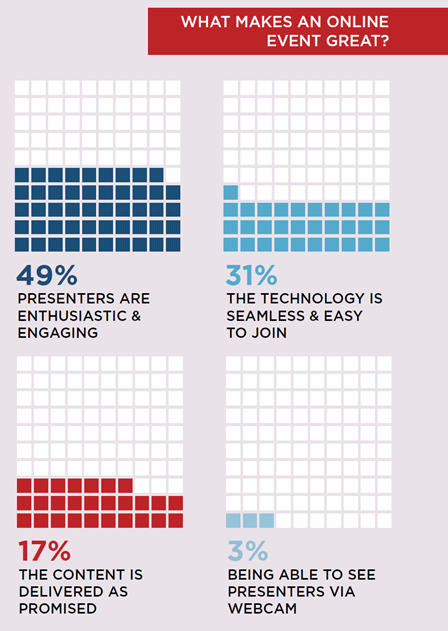
Your personality needs to overcome the technology that people sometimes perceive as a barrier. And what’s interesting is that seeing someone on webcam isn’t the be all and end all of a live event!
My last point is that we can only do all of this with great planning, design, practice and people! This is a facilitator guide template you can download and adapt to make it right for you.
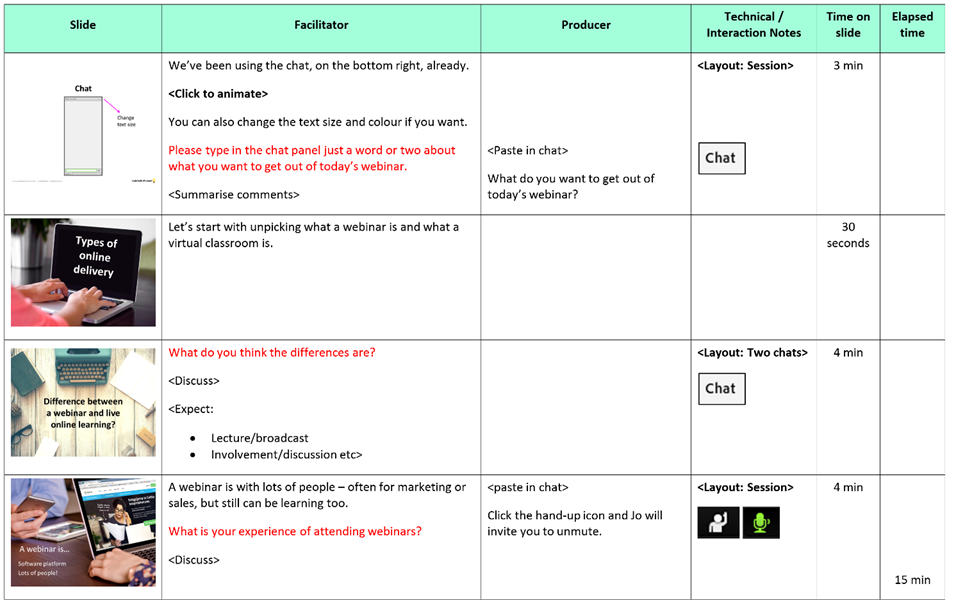
This isn’t just about having an interaction every few minutes for the sake of it – it’s about you digging into the detail of why and what that interaction can do for you and your attendees. This is all about helping you with your design and supporting your delivery and you can read more online.
We should be taking advantage of what live online delivery can offer us, which is to actually break apart our delivering, give space between sessions so that people can still focus on their work and deadlines, as well as have the time to put things into practice.
This also allows you to focus much more on the learner, as you aren’t having to or being asked to add in more content to justify people being out of the office or the cost of travel and accommodation.
Lightbulb Moment: live online training for your team
We offer training courses, a community forum for support, and a whole host of free resources such as videos and podcasts to help you make your live online learning not just as good as face-to-face – but better.

